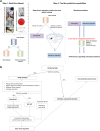Predicting the microbial cause of community-acquired pneumonia: can physicians or a data-driven method differentiate viral from bacterial pneumonia at patient presentation?
- PMID: 32143620
- PMCID: PMC7060632
- DOI: 10.1186/s12890-020-1089-y
Predicting the microbial cause of community-acquired pneumonia: can physicians or a data-driven method differentiate viral from bacterial pneumonia at patient presentation?
Abstract
Background: Community-acquired pneumonia (CAP) requires urgent and specific antimicrobial therapy. However, the causal pathogen is typically unknown at the point when anti-infective therapeutics must be initiated. Physicians synthesize information from diverse data streams to make appropriate decisions. Artificial intelligence (AI) excels at finding complex relationships in large volumes of data. We aimed to evaluate the abilities of experienced physicians and AI to answer this question at patient admission: is it a viral or a bacterial pneumonia?
Methods: We included patients hospitalized for CAP and recorded all data available in the first 3-h period of care (clinical, biological and radiological information). For this proof-of-concept investigation, we decided to study only CAP caused by a singular and identified pathogen. We built a machine learning model prediction using all collected data. Finally, an independent validation set of samples was used to test the pathogen prediction performance of: (i) a panel of three experts and (ii) the AI algorithm. Both were blinded regarding the final microbial diagnosis. Positive likelihood ratio (LR) values > 10 and negative LR values < 0.1 were considered clinically relevant.
Results: We included 153 patients with CAP (70.6% men; 62 [51-73] years old; mean SAPSII, 37 [27-47]), 37% had viral pneumonia, 24% had bacterial pneumonia, 20% had a co-infection and 19% had no identified respiratory pathogen. We performed the analysis on 93 patients as co-pathogen and no-pathogen cases were excluded. The discriminant abilities of the AI approach were low to moderate (LR+ = 2.12 for viral and 6.29 for bacterial pneumonia), and the discriminant abilities of the experts were very low to low (LR+ = 3.81 for viral and 1.89 for bacterial pneumonia).
Conclusion: Neither experts nor an AI algorithm can predict the microbial etiology of CAP within the first hours of hospitalization when there is an urgent need to define the anti-infective therapeutic strategy.
Keywords: Artificial intelligence; Community-acquired pneumonia; Diagnosis.
Conflict of interest statement
The authors declare that they have no competing interests.
Figures



References
-
- Home | AMR Review. https://amr-review.org/. Accessed 7 Feb 2019.
-
- Agency for Healthcare Research & Quality. https://www.ahrq.gov/. Accessed 7 Feb 2019.
MeSH terms
LinkOut - more resources
Full Text Sources
Other Literature Sources
Miscellaneous

